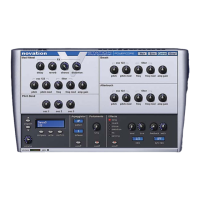Using the V-Station
If you want to over-write the existing sound, simply click on CONFIRM - the sound will be written
to the current location.
Note : The destination memory is always initially set to the currently selected program’s
number. Take care not to accidentally overwrite a treasured preset!
If you want to save the sound in a different location (thereby retaining the original sound in its
original location), using the PROGRAM up/down buttons, select the destination memory and
click on CONFIRM.
To cancel the WRITE operation, simply click on WRITE again.
Loading and saving banks
Most sequencer hosts allow you to load and save banks of sounds. This is useful if you want to
create your own library of sounds and you could, for example, create a set of, say, ‘techno’
sounds on your V-Station - these could be saved as a bank named “Techno”. You might also
create a series of ‘vintage’ synth emulations - again, these could be saved as a bank called
“Vintage”. Whatever... you can subsequently load all these sounds back into your V-Station at
any time. In this way, you can build up your own private library of V-Station sounds. It’s also
likely that banks of sounds will appear on the Internet which can be downloaded and used with
your V-Station.
You should consult your sequencer’s documentation for details on loading and saving banks.
Note : We have used the term ‘bank’ to describe a collection of sounds that can be loaded /
saved on a plug-in. Different sequencers use different terminology for the same thing.
Notes about loading and saving generally
There are generally three ways to load and save items within your sequencer and to confuse
the issue, different sequencers either deal with this differently and/or use their own
terminology for what is basically the same process!
At the top level, you can save your song. This will not only save the music you have recorded
but it will also save the current settings of the V-Station (and any other plug-in(s) you may have
running). When you subsequently load that song, the V-Station’s sound(s) will also be
recalled. Even if you have edited a sound, the edited version will be recalled when the song is
opened again.
At the next level, you can save (or ‘write’) individual sounds to the V-Station’s ‘internal’ memory.
Thus, whenever you use the V-Station in any song, the sounds you have edited / created can
be used in that song.
However, once you start building up lots of sounds of your own creation, you can save these
as a bank (or or ‘preset’ or ‘setting’ or whatever it is your sequencer calls them) and these can
be loaded into the V-Station quite separately from the song. To illustrate this, you could be
working on a song but can’t find the right sound. You can load a different bank of sounds into
the V-Station where you have access to 400 different sounds.
Some sequencers also allow you to save single sounds and these can subsequently be
loaded into the V-Station at a later date.
Don’t be confused by all of this, however - most of the time, you will simply insert instances of
the V-Station into your song, select sounds as required (maybe even tweak them to suit the
song) and then you’ll just save the song’s sequence file. When you load that song again, the
instances of the V-Station will be recalled along with the sounds you selected / edited. The
WRITE and SAVE / LOAD BANK (or whatever) options are more for building up a library of your
own sounds.
7 Getting Started

